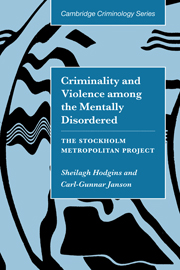Book contents
- Frontmatter
- Contents
- List of figures
- List of tables
- Preface
- Introduction
- Chapter 1 Research on the criminality and violence of the mentally ill
- Chapter 2 The longitudinal approach
- Chapter 3 Swedish society and Stockholm: the cohort and its context
- Chapter 4 Criminality
- Chapter 5 Explanations of the criminality of the mentally ill
- Chapter 6 Early and late-starters
- Chapter 7 Conclusion
- References
- Index
Chapter 4 - Criminality
Published online by Cambridge University Press: 22 September 2009
- Frontmatter
- Contents
- List of figures
- List of tables
- Preface
- Introduction
- Chapter 1 Research on the criminality and violence of the mentally ill
- Chapter 2 The longitudinal approach
- Chapter 3 Swedish society and Stockholm: the cohort and its context
- Chapter 4 Criminality
- Chapter 5 Explanations of the criminality of the mentally ill
- Chapter 6 Early and late-starters
- Chapter 7 Conclusion
- References
- Index
Summary
We first proceeded with an epidemiological investigation comparing convictions for criminal offences among subjects in the five groups. Three groups of subjects had been admitted to a psychiatric ward by age 30: (1) those with diagnoses of major mental disorders; (2) those with alcohol and/or drug related disorders; (3) those with other disorders. A fourth group of subjects were mentally retarded, and the fifth group is composed of all those cohort members who had never been admitted to a psychiatric ward nor to a special stream in school for retarded children.
PREVALENCE OF CRIMINALITY AMONG THE PROJECT METROPOLITAN SUBJECTS
Table 4.1 presents the percentages and numbers of subjects in each group that had been convicted of at least one crime by age thirty. Among the men with no mental disorder or retardation, 31.7% were registered for a crime. In comparison, 50% of those with a major mental disorder, 92.9% of those with a diagnosis of substance abuse/dependence, 37.5% of those with other mental disorders, and 56.7% of the mentally retarded men were registered for at least one crime. The pattern is similar among the women. While 5.8% with no disorder were registered for at least one crime, 19.0% of those with a major mental disorder, 12.1% of those with other mental disorders, 70.7% of those with diagnoses of substance abuse/dependence, and 16.1% of the mentally retarded women were registered for at least one crime.
- Type
- Chapter
- Information
- Criminality and Violence among the Mentally DisorderedThe Stockholm Metropolitan Project, pp. 77 - 107Publisher: Cambridge University PressPrint publication year: 2002
- 1
- Cited by

